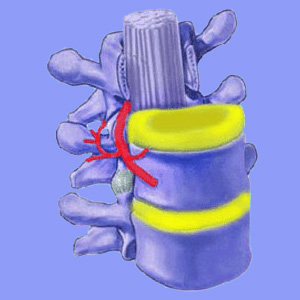
A pinched nerve is one of the main reasons used to explain general lower back pain and is even more prevalent as the direct cause of sciatica. Compressed spinal nerve roots can occur in many patients, but also may be inaccurately diagnosed, making them possible sciatica scapegoats in some instances.
Neuropathy conditions are the most difficult to accurately diagnose and pinched nerves are no exception to this rule. Statistics demonstrate a terrible incidence of misdiagnosis in patients deemed to be suffering from compressive neuropathy syndromes, especially those who were not diagnosed by a neurologist.
This article will discuss how pinched spinal nerve roots may cause or contribute to sciatic nerve symptoms, as well as how compressed nerves are often mistakenly implicated in these same painful expressions.
What is a Lumbar Pinched Nerve?
Compressed nerves occur when one or more of the spinal nerve root components, which exit the spinal canal at each vertebral level, are impinged upon by some other structure. The most commonly diagnosed causes of nerve compression are herniated discs and spinal osteoarthritis.
The nerve is usually said to be pinched as it exits the neuroforaminal opening by the disc or bone structure. This process is known as foraminal stenosis. In other cases, the nerve roots may be affected individually or en masse in the central canal space through spinal stenosis. Remember, the spinal cord ends above the most affected lumbar levels which are involved in causing sciatica, so the cauda equina exists freely in the central canal space.
Other less diagnosed causes of pinched spinal nerve roots might include extreme spondylolisthesis, scoliosis, hyperkyphosis or hyperlordosis. However, many other mechanical compression scenarios may exist in less common instances.
Compressive Neuropathy Facts
Here are some lesser known or lesser considered facts about compressive neuropathy conditions:
Although it is one the most common back and neck pain diagnoses, pinched nerves rarely actually cause chronic pain. Instead, pain is typically transient and replaced by numbness and weakness over time.
In order for a nerve to be truly pinched, the neuroforamen or central canal would have to be virtually completely sealed off. This is an extremely infrequent event, even in cases of severe trauma and degeneration.
Pinched spinal nerves will usually elicit well defined and structured symptoms in specific locations of the anatomy. If symptoms do not correlate by expression or location, then the diagnosis may be unsound.
Radicular pain is one of the most difficult syndromes to diagnose correctly, due to the complexity of the neurological system and the common incidence of circumstantial structural abnormalities, which may be present, but are not actually pinching any nerve tissue.
Pinched Nerve Conundrum
Nerves are far smaller than the neuroforamen through which they pass. The cauda equina is much smaller than the central canal space. Therefore, there really must be significant stenosis of either space in order for nerve compression to occur.
The spine has evolved over millions of years as the ideal structure for maintaining skeletal support and providing us all the amazing functionality that we, as humans, enjoy. Some pinched spinal nerve diagnoses are fundamentally flawed. To say that every degenerative process which is typical, normal and even universal in the spine would cause our very neurological systems to fail and cause us such pain, is ridiculous. The mere thought is illogical.
I was diagnosed with radicular pain from 2 compressed nerves caused by herniated discs at L4/L5 and L5/S1. The diagnosis seemed to make perfect sense to me as a layman. That is, at the time. But, as my pain grew and became a nightmare of suffering and agony, I was sure something was not right. After all, if the diagnosis was correct, how come all of the treatments I attempted failed so abysmally?
Well, with some independent research, I eventually got my brain up to speed on the actual sciatica facts which had eluded me for so long. I learned why many pinched spinal nerve diagnoses did not make sense and discovered that in my case, the symptoms were far too diverse to be explained by this mistaken diagnostic theory. This is even long before I discovered 10 more herniations in the upper end of my spine and the significant spinal cord displacement enacted by a particularly bad cervical disc prolapse.
Do not wait if you suspect that something is not right in your diagnostic process. Be proactive and make it right. Seek neurological evaluation of any suspected pinched nerve from a specialist in spinal neurology. Also, take part in your care by learning all you can about your diagnosis and how it may or may not explain all your symptoms.





